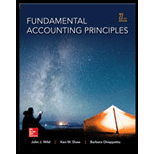
Concept Introduction:
Inventory: These are goods which are owned by company and expected to sell in its normal course of business
Merchandise: The goods are referred as merchandise which the company purchases and resells the same goods to customers
Merchandiser: The company who business is to buy the merchandise at purchases cost and sell the same merchandise at higher price which is sales price and earns profit . Merchandiser can be categorized as wholesaler and retailer
Perpetual Inventory System: Each merchandise purchase and sales cost are recorded and updated continuously for all merchandise. In perpetual Inventory system if merchandise is sold. The company determines the cost of goods sold and passes an accounting entry. It will debit “Cost of goods sold” and credit “Merchandise Inventory” . If merchandise is purchased it will pass the accounting entry by debiting “Merchandise Inventory” and crediting “Account payable” if purchases on credit or “Cash or Bank “if paid Cash or Cheque for the purchases
Closing entries for merchandisers in perpetual inventory system: At the end of accounting period all temporary accounts are transferred to income summary and then the balances income summary is transferred to owners capital
To Prepare:
To record
- The
adjusting entries - The closing entries
Want to see the full answer?
Check out a sample textbook solution
Chapter 5 Solutions
Fundamental Accounting Principles -Hardcover

 AccountingAccountingISBN:9781337272094Author:WARREN, Carl S., Reeve, James M., Duchac, Jonathan E.Publisher:Cengage Learning,
AccountingAccountingISBN:9781337272094Author:WARREN, Carl S., Reeve, James M., Duchac, Jonathan E.Publisher:Cengage Learning, Accounting Information SystemsAccountingISBN:9781337619202Author:Hall, James A.Publisher:Cengage Learning,
Accounting Information SystemsAccountingISBN:9781337619202Author:Hall, James A.Publisher:Cengage Learning, Horngren's Cost Accounting: A Managerial Emphasis...AccountingISBN:9780134475585Author:Srikant M. Datar, Madhav V. RajanPublisher:PEARSON
Horngren's Cost Accounting: A Managerial Emphasis...AccountingISBN:9780134475585Author:Srikant M. Datar, Madhav V. RajanPublisher:PEARSON Intermediate AccountingAccountingISBN:9781259722660Author:J. David Spiceland, Mark W. Nelson, Wayne M ThomasPublisher:McGraw-Hill Education
Intermediate AccountingAccountingISBN:9781259722660Author:J. David Spiceland, Mark W. Nelson, Wayne M ThomasPublisher:McGraw-Hill Education Financial and Managerial AccountingAccountingISBN:9781259726705Author:John J Wild, Ken W. Shaw, Barbara Chiappetta Fundamental Accounting PrinciplesPublisher:McGraw-Hill Education
Financial and Managerial AccountingAccountingISBN:9781259726705Author:John J Wild, Ken W. Shaw, Barbara Chiappetta Fundamental Accounting PrinciplesPublisher:McGraw-Hill Education





